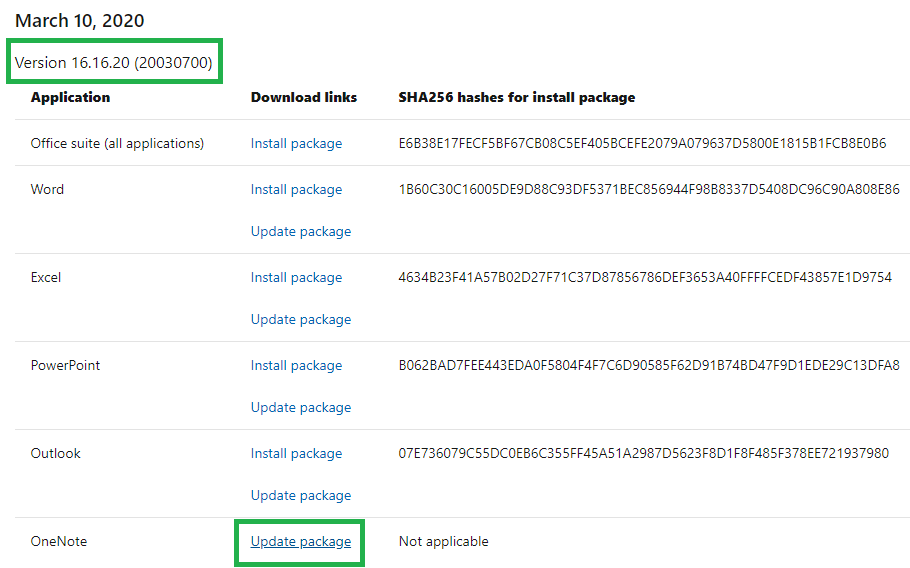While click-to-run Office usually automatically updates directly from Microsoft server and no update history would be recorded in Microsoft Update of Control Panel. To update Office 2016 application manually, please open any Office 2016 application, choose File Account Update Options Update Now.
UPDATE JANUARY 2020: SOLVED: Setup Office365ProPlus To Using Windows 10 Delivery Optimization
Office 2016 automatically saves versions of your SharePoint and OneDrive for Business files while you’re working on them. These versions allow you to look back and understand how your files evolved over time and allow you to restore older versions in case you make a mistake. We have a volume license for Office 2016 Standard with about 700 installs. About 30% of our PC are behaving as described below. When we install Office on a new PC it appears to have installed and activated just fine and the end user will use Office with no problems for about 2-3 months then the problems start. And since the Mac OS has updated to the latest version, I suggest you check if the Outlook 2016 for Mac desktop client is the latest version. You can refer to Outlook for Mac update history and make a contrast. Besides, there’s an known issue that Outlook for Mac crashes after the Cisco WebEx Productivity Tools plug-in is installed. Microsoft Office 2016. As with previous versions, Office 2016 is made available in several distinct editions aimed towards different markets. All traditional editions of Microsoft Office 2016 contain Word, Excel, PowerPoint and OneNote and are licensed for use on one computer.
____________
There are three ways to patch Office 2016 from Office365 :
- Automatically from Microsoft through their “Content Delivery Network” (default)
- Using a distribution point that you update periodically
- Using System Center that pulls its updates from the Microsoft Content Network
What you can’t do is control Office365 updates through WSUS. Wait a minute, you say you saw a WSUS category named OFFICE365 CLIENT and the research says that it is the Office 2016 updates. That is true, but shockingly it does not work in WSUS. That category was added for System Center:
…Deploying these updates without Configuration Manager is not supported, so the content described above is essentially useless to a WSUS standalone administrator… we recommend that you… deselect the Office 365 Client product so that WSUS does not sync this content from Microsoft Update…
…There are no plans to support this via WSUS standalone at this time. My preference would be to support this scenario without the use of this workaround, which is not possible with the current implementation.
Also, how can it be that Windows Update does not handle the updates for Office365 versions of Office 2016? Windows Update does not push updates to Click to Run software which is what Office 365 Office 2016 is. Click-to-Run is a Microsoft technology that virtualizes programs (like a Virtual Machine, but a Virtual App). For more information on Click to Run, read THIS.
I confirmed with Microsoft Partner Support that WSUS can be used for all other updates while SCCM handles just the Office 365 Office 2016 updates. This scenario plays out in many branch offices. See the post for more details.
You might also think, ‘hey, how large can Office 2016 updated be?’ Large enough to bog down your network. See this post for specific sizes.
Lets quickly go through each of the three Office 2016 update options for Office 2016:
AUTOMATIC UPDATE OFFICE365 Office 2016 THROUGH THE MICROSOFT CONTENT NETWORK

If you have Office365 Office 2016 in your company and you have not made changes to the default configuration, you are not controlling the Office 2016 patches. Office 2016 (and 2013) will periodically check for Windows Updates and silently install them automatically weather you want them to or not:

…Click-to-Run products are configured to be updated automatically over time. Users don’t have to download or install updates. The Click-to-Run product seamlessly updates itself in the background…
https://technet.microsoft.com/en-us/library/jj219427.aspx
Update History For Office 2016 Mac
UPDATE OFFICE365 Office 2016 FROM A DISTRIBUTION POINT
You can use the command line Office Deployment Tool to download updates to a network share and then use one of two ways to tell you Office 365 Office 2016 (and 2013) clients where to source them from:
- GPO: COMPUTER CONFIGURATION > POLICIES > ADMIN TEMPLATES > MICROSOFT OFFICE 2016 (MACHINE) > UPDATES > UPDATE PATH
- During the install of your Office365 Office 2016 you can set the updates share in the “configuration.XML” file you use.
…
<Updates Enabled=”TRUE” Channel=”Current” UpdatePath=”<Server><ShareThatContainsUpdates>” />
…
See THIS Partner Post for more detail.
UPDATE OFFICE365 Office 2016 FROM SYSTEM CENTER CONFIGURATION MANAGER
In this scenario, you simply need to go through three steps
Update Office For Mac
- Create and apply the following GPO:
COMPUTER CONFIGURATION > ADMIN TEMPLATES > MICROSOFT OFFICE 2016 (MACHINE) > UPDATES > OFFICE 365 CLIENT MANAGEMENT = ENABLED - In SCCM go to ADMINISTRATION > OVERVIEW > SITE CONFIGURATION > SITES > CONFIGURE SITE COMPONENTS (this is a button at the top) > SOFWARE UPDATE POINT
- > CLASSIFICATION (tab) enable UPDATES
- > PRODUCTS (tab) enable both OFFICE365 CLIENT and OFFICE 2016
- In SCCM go to SOFTWARE LIBRARY > OVERVIEW > SOFTWARE UPDATES > ALL SOFTWARE UPDATES and set the deployment you want
This short video from Microsoft does an excellent job of explaining these instructions:
Office Version History For Mac
You may find the following referencing handy:




